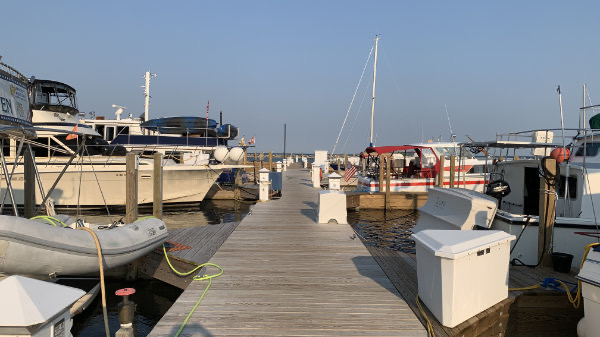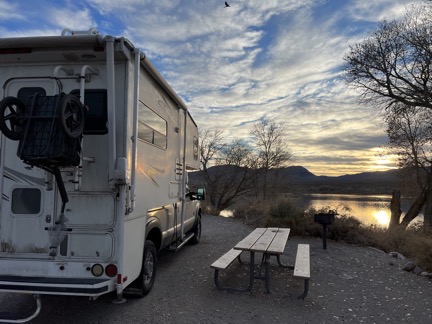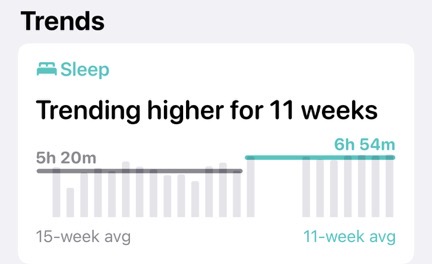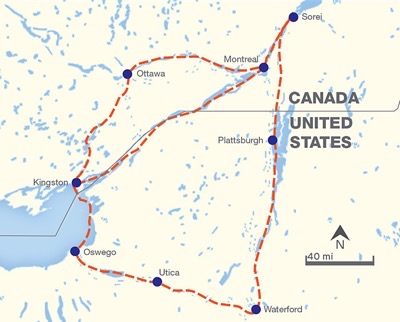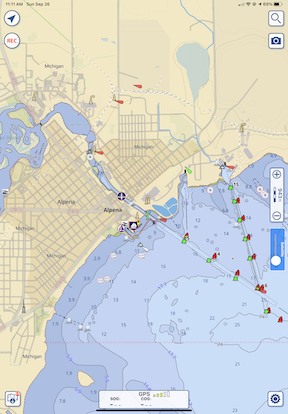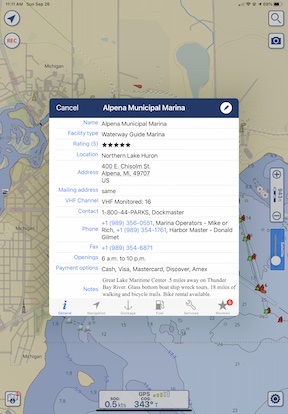A relatively quick answer to the question, “How was your trip?”
As regular readers might know, I was away for a little more than five weeks from late March through May 1 on yet another Great Loop boat trip. I began blogging it in a separate blog I started just to report the trip but I soon felt as if there wasn’t much to report so I let it slide. I’m still hoping to catch up, although as each day passes, it becomes a little less likely.
That should give you a sort of preview of what I’m about to report.
Better …
The trip was certainly better in many respects than my first Great Loop trip.
If you recall, that trip had three of us on a 27′ Ranger Tug. That would have been fine if we all got along well, but I almost immediately started having trouble with the other crewmember who remains one of the most difficult people I’ve ever had to deal with. (My ex-sister-in-law probably tops her, but not by much.) I was supposed to be on the trip for 8 weeks but had had enough long before I finally departed after just five weeks.
On this trip, it was just me and the captain on a 36′ Carver and we got along fine. I know we had differences in opinions on politics — he watches/read Fox News — but as long as he didn’t bring anything up, I didn’t have to either. We both like to visit museums and the like and we did some of that together. One thing I learned not to do with him was to take walks through the port towns if I expected to shop; he was not interested in that at all and I felt pressured to walk slowly but shop quickly. We also ate a lot of meals together on the boat, which saved a ton of money. Speaking of money, he covered all the costs of fuel and marinas so this trip was a lot cheaper and that’s good, too.
… but also worse
It was also a bit disappointing when compared with my first trip.
On that trip, Captain Paul’s primary interest was covering as many miles as we could so he could stay “on schedule” and finish the trip quickly. As a result, we were moving on the water more than half the days. I was able to log 23 sea days in five weeks. We covered over 1,200 miles.
On this trip, Capt John and I spent a lot of days at marinas. There was five nights at Charleston, six nights in Georgetown, and three nights each at Southport, Carolina Beach, Swansboro, and Beaufort. This pace was a lot slower than I’d expected. While these port towns were nice, most of them certainly didn’t provide enough entertainment for the number of days we were there — especially since we didn’t have access to ground transportation other than bicycles once we left Charleston. In just over five weeks, I was only able to log 13 sea days covering 325 NM.
What I learned from this is that I’d like to do the trip slower than Capt Paul but faster than Capt John. I’m thinking that one or two nights in each port town — perhaps with more stops along the way — is more in line with what I’d like to do.
Real Life Experience
I got valuable real-life boating experience on both trips.
The first trip taught me about travel along major rivers (the Hudson, the Niagara, the Detroit, and the St. Clair), dealing with locks and drawbridges on the Erie Canal, and travel on some pretty large lakes, including Lake Erie and Lake Huron.
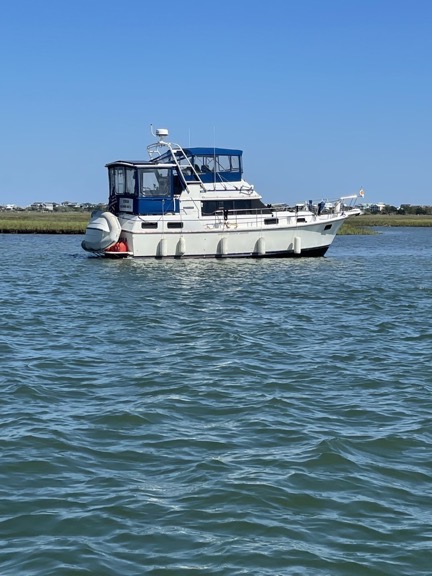
A passing boater sent us this photo of us grounded. The situation got worse before it got better; we were there for about 4 hours before the tide finally lifted us free.
This trip taught me more about navigating tidal waters, including those with extensive shoaling. I experienced what it was like to get grounded — twice, although we were able to get ourselves out quickly the second time. I also experienced tidal flows and currents, although nothing like what I experienced years before on my Inside Passage trip.
Both trips taught me about marinas — we never once anchored out on either trip — and what I can expect to find at them: dockhands that do or don’t know what they’re doing, dockmasters who care or don’t care about boaters, types of floating or non-floating docks, fuel docks, restrooms, showers, laundry facilities, marina shops, ground transportation — the list goes on and on. We stayed at some really great marinas and a handful of crappy ones on both trips.
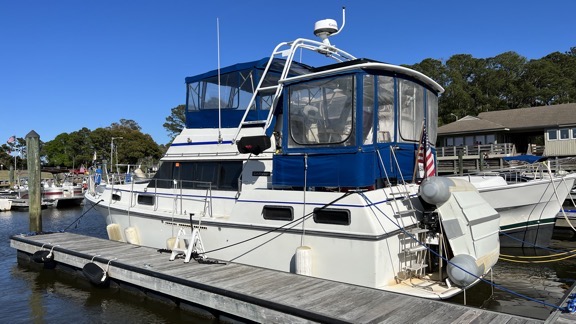
Here’s the boat at Carolina Beach State Park Marina. I liked this marina, but I didn’t like being stuck there so long. The very valid excuse was weather, although we could have left the day before the weather arrived.
I went on short dinghy rides on both trips. Capt Paul’s dinghy was incredibly impractical in that it was stowed on the deck under a piece of furniture and had to be inflated and the two-part motor charged and attached before use. Capt John’s dinghy was affixed to the swim platform and was more practical, although the motor had to be attached and the fuel loaded on board before it could be used. I’d take Capt John’s solution over Captain Paul’s any day. But since we never anchored out, we didn’t really need a dinghy so I didn’t get much experience with either one.
Food
Both trips taught me about the importance of having food on board.
On Capt Paul’s boat, the only meal we ate on board was breakfast and it was limited to cereal or bread. When we arrived at a port, we were usually very hungry and the first order of business was finding someplace to have lunch. Sometimes it was difficult or nearly impossible, especially after Labor Day when a lot of places seemed to be closed for the season.
Capt John, on the other hand, wanted to eat every meal on board. The trouble is, boats don’t have very large refrigerators so we really had to plan accordingly. Capt John liked to make huge meals in his crockpot so we wound up eating the same thing multiple times a week — and beyond, although I stubbornly refused to eat leftovers over a week old. (Ick.) Those leftovers took up a lot of space in the fridge so we couldn’t buy the kinds of fresh vegetables and other ingredients I like to have on hand to cook meals. We also didn’t have much freezer space because, for some reason, Capt John liked to make and store ice. We didn’t use much so we always had about a week’s worth. (For my own boat, I’ll make sure to have plenty of nonperishable foods on board, including canned soup, stew, and sardines; crackers; pasta and pasta sauce; and canned meal ingredients.)
Ground Transportation
Of course, the main challenge to having food on board is getting it there — without ground transportation it’s difficult to go grocery shopping. While Capt Paul had no way to get around when we parked at a marina, Capt John had two nice little folding bikes. I got the experience of shopping with him and filling our little backpacks with as much as we could stuff inside them so we could pedal back to the boat and fill the fridge.
The ground transportation experience was about what I expected. It had been very frustrating to be without ground transportation while traveling with Capt Paul — we wound up doing a lot of walking in heat and humidity. The bicycles, although not perfect, we must-have equipment for a trip. When it comes time for me to equip my boat, I’ll be including putting my battery assist bike with its little trailer; I expect shopping and just getting around to be a lot easier.
Other Stuff on Board
The only thing about this trip that I had a real problem about was the amount of extra stuff Capt John had on board. We had numerous fuel containers, and spare cushions, and several folding chairs and tables. We had two barbecue grills. We had a cooler we never used. We had two sets of 50-foot long 30 amp extension cords. We had tons of extra line, some of which was frayed and should have been discarded. There were buckets of rags and cleaning supplies in addition to the cabinet full of rags and cleaning supplies. This extra stuff took up space on deck, making some of the seats unusable. And I don’t even know about the extra stuff that he was storing in his cabin.
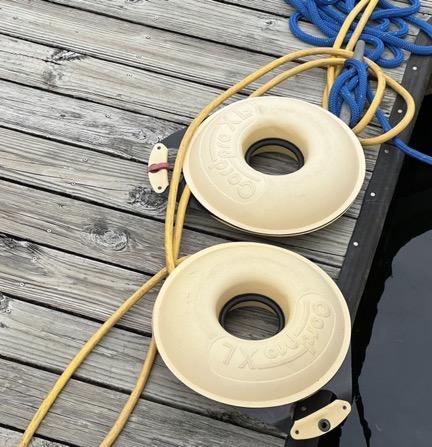
There wasn’t anything on board that was more of a pain in the ass than these cord “donuts.”
He was also big on gadgets. He had these special things I called “donuts” to roll up the 30 amp power cords but although they were attached to our main cords, we never once used them to roll up the cords. Instead, they just dangled, often in the way, on deck or on the dock when we plugged in. He also had these gadgets for adjusting the length of the ropes holding the fenders in place. They would have been a good idea if they worked properly, but they didn’t. They got stuck in the open position, dropping the fenders to the lowest position, often when you were trying to raise them before docking. And yes, he had a device with the sole purpose of making hard-cooked eggs; he ate three of them daily and cooked up 2 dozen at a time so there were always some in the fridge.
I am the clutter queen at home, but after living on a boat with so much clutter for 5 weeks, I’m going to make sure I don’t have any more equipment than I really need on my boat.
Docktails
One of the things I really liked about Capt John was how social he wanted to be with other “Loopers.” He would actively search for them at the marinas and, more than once, invite them for docktails — drinks at our boat. The way docktails work is that the folks you invite come with their own drinks and, often, a little snack like chips to share. You sit on the aft deck or inside, if the weather is bad, and chat about your trip to date. It’s a great way to learn about points of interest along the way, good (or bad) marinas, and hazards. We had at least five couples over for docktails on our trip and they were all different and interesting.
Captain Paul, on the other hand, seemed to have no interest in meeting other boaters. Even when we were at marinas with numerous other “Loopers,” he kept to himself. I was kind of shy and didn’t feel that I should be inviting strangers over to his boat — especially since he turned in so early some nights — so I completely missed out on any opportunity to meet other boaters. I’m really looking forward to having my own boat and inviting others over for docktails and a chat.
The Bottom Line
Although this most recent trip did give me plenty of marina experience and other general boating experience, it didn’t give me the number of sea days I was really hoping to earn. I earned 23 days out of 35 with Capt Paul and only 13 out of 40 with Capt John. Yes, it cost a lot less money, but my time these days is worth more than money. This was the most disappointing thing about the entire trip.
Was it worth it? I can’t say yes but I can’t say no. I can say this: I won’t do another trip like this unless I know I’ll earn at least one sea day per every two days of the trip. That means one thing: the next trip will have to be in my own boat with me calling the shots.
Now all I have to do is find and buy the boat.

